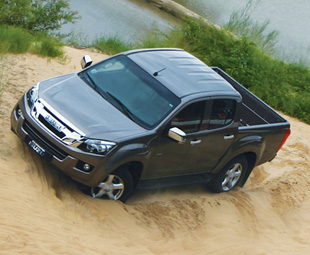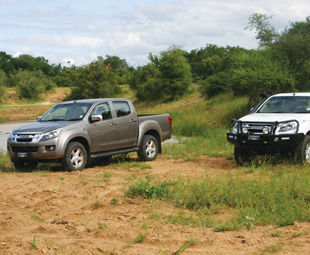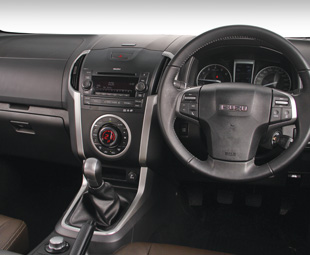Latest and greatest?

The fifth-generation Isuzu KB has been one of the country’s favourites. But with the launch of its successor – built in South Africa for South Africa – Isuzu aims to take top spot, learns GAVIN MYERS.
Launched last month at the spectacular Thorybush Game Lodge in the Limpopo lowveld, the new Isuzu KB range of single, extended and double cab bakkies is exactly what the brand has needed to tackle new entrants to the market. With the previous fifth generation having been with us since 2004, one would be tempted to say its replacement has been long overdue. Nevertheless, KB 5 was a popular choice for local privateers and fleets – as were all versions before it.
We were lucky enough to be reminded of this at the reveal of the sixth generation, or KB 6; kicking off with a drive in the outgoing model for a bit of a refresher. The trip down memory lane didn’t stop there, though, as Isuzu took us back over 40 years – to 1972 – with a presentation on the history of the KB brand and an example of each of the new model’s forebears on display.
With the KB 6, Isuzu plans to hit the market hard. It was jointly developed by engineers from Isuzu and General Motors, and significant emphasis was placed on the requirements of South African customers. With the range offering 26 models to chose from, the company has made sure that the right vehicle for the job exists. The 26 models are broken down into combinations of three body styles of single, extended and double cab; engine options of 2,4-litre petrol and 2,5- and 3,0-litre diesel; spec options of Base, Fleetside, LE and LX; gearbox options of five-speed manual or automatic; and drive options of 4×2 or 4×4.
 New to the range – in the form of the KB 240 – is a 2,4-litre 16-valve petrol engine delivering 112 kW at 5 200 r/min and 234 Nm at 4 000 r/min. There are two
New to the range – in the form of the KB 240 – is a 2,4-litre 16-valve petrol engine delivering 112 kW at 5 200 r/min and 234 Nm at 4 000 r/min. There are two
2,5-litre diesel options (the KB 250 delivering 58 kW at 3 800 r/min and 176 Nm at 1 800 r/min and the KB 250 D-TEQ delivering 85 kW at 3 600 r/min and
280 Nm at 1 800 r/min) which have been carried over from the previous generation and will be upgraded in due course. The upgraded 3,0-litre D-TEQ on the KB 300 models (only in top LX spec) is good for 130 kW at 3 600 r/min and 380 Nm at 1 800 – 2 800 r/min. This engine has undergone significant revision for the latest generation; with a variable-geometry turbocharger, reduced engine internal friction, optimised fuel injection and a new large front-mounted intercooler (this is also in line with stringent pedestrian safety legislation).
On both D-TEQ engines the oil filter has been re-located to the top of the engine to aid servicing, while the engines have also been made quieter and more durable through numerous mechanical changes.
Isuzu has taken an interesting route with gearbox options, offering only a five-speed manual with the option of a five-speed automatic on the LX-spec models. However, it doesn’t seem to cause the vehicles to struggle; they pull well and the drivelines are smooth. Drive modes on models fitted with the 4×4 drivetrain are selected by way of a new “Terrain Command Dial” and an electronic diff-lock is fitted. The vehicles put on a good show on a relatively challenging off-road course, with the strong 2,4-petrol impressing to the point where it had some passengers going “Oh, we were in the petrol model?”
An area of development where General Motors South Africa (GMSA) had considerable input was with regards to the suspension set-up and tuning of KB 6. The all-new front suspension comprises of a double-wishbone arrangement with coil springs, while the rear retains the traditional leaf springs. On low-ride models the springs are longer and mounted under the drive axle to provide for a low cargo floor to ground measurement, while on high-ride models the springs are “overslung” to improve ground clearance. Impressively, Gross Vehicle Mass ratings range from 2 850 kg to 3 100 kg with payload ratings from 962 kg to 1 146 kg. Isuzu is also proud that the 3,0-litre models have an impressive 3 500 kg towing capacity – one of the highest of any light pick-up.
The new, stronger chassis is longer and wider than previous models and the wheelbase has been stretched by 45 mm. The new chassis and suspension setup give the KB 6 a much improved ride, while handling is more surefooted and stable. On that note, an interesting point is that local vehicles are not fitted with electronic traction or stability control at this stage, but this will apparently be added in due course.
 Both the exterior and interior of the KB 6 have benefited from a complete redesign. The exterior has a much bolder look than any KB before it and – as with all modern bakkies – has grown substantially. It does, however, hide its new bulk well; seeming much smaller than it really is. An interesting design feature, of particular interest to the off-road brigade, is the integration of the towbar into the rear step bumper – minimising its impact on departure angle.
Both the exterior and interior of the KB 6 have benefited from a complete redesign. The exterior has a much bolder look than any KB before it and – as with all modern bakkies – has grown substantially. It does, however, hide its new bulk well; seeming much smaller than it really is. An interesting design feature, of particular interest to the off-road brigade, is the integration of the towbar into the rear step bumper – minimising its impact on departure angle.
The interior is more upmarket and cosseting and build quality seems “top drawer”. There are, however, a few ergonomic design issues that simply shouldn’t be there. Isuzu has addressed the issue of rear entry and exit, inherent in double cabs; designing the doors and their opening angle to allow more space. Overall though, interior space, comfort and ambiance are good.
“The Bakkie Specialists”, Isuzu has designed a bakkie range that it believes will take the fight to others at the top of the segment. Initial impressions are of an accomplished range that will certainly continue to be a top seller. But, this sixth-generation KB is not without its flaws. Whether it will become the country’s favourite bakkie, however, can only be answered over time. Watch out for a full review in a later edition of FOCUS.
Published by
Focus on Transport
focusmagsa




